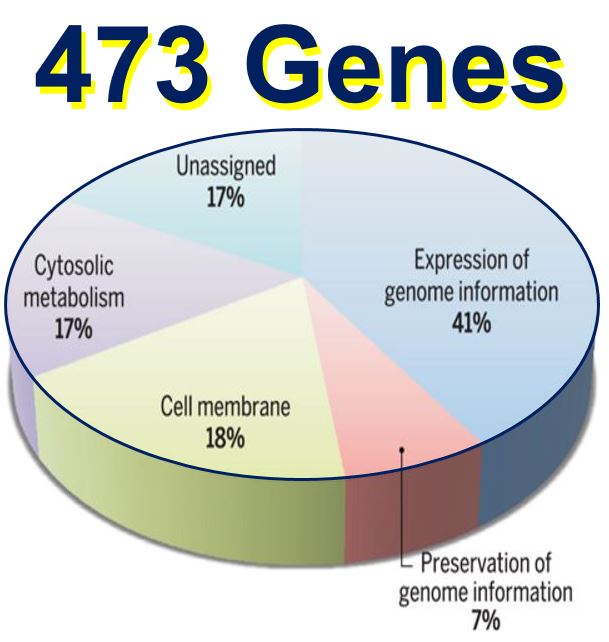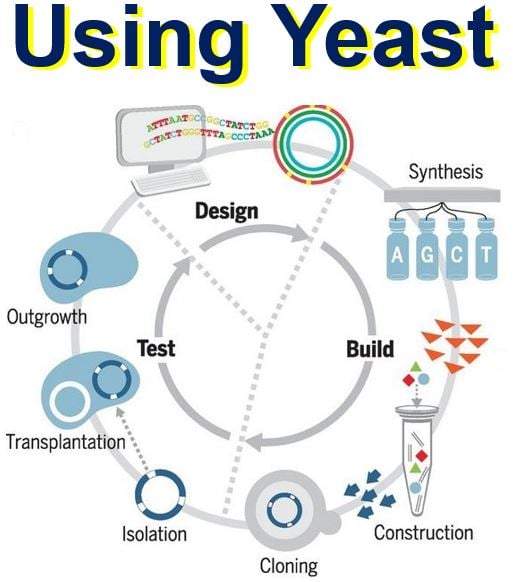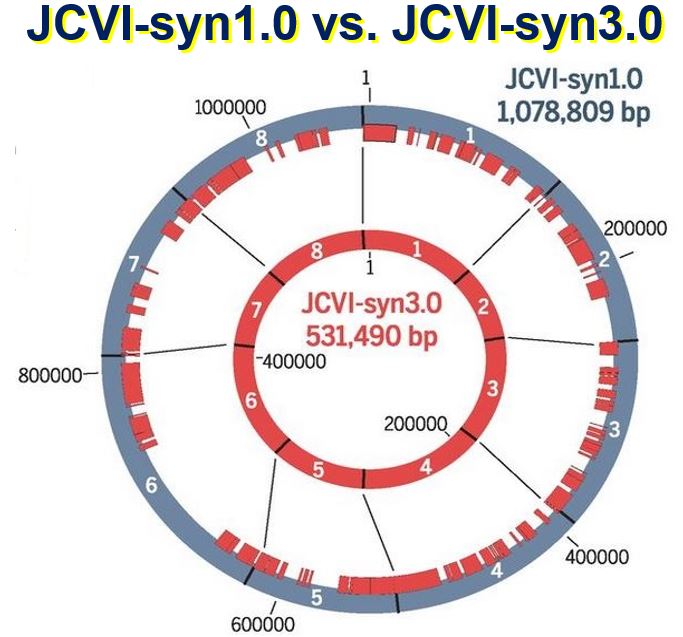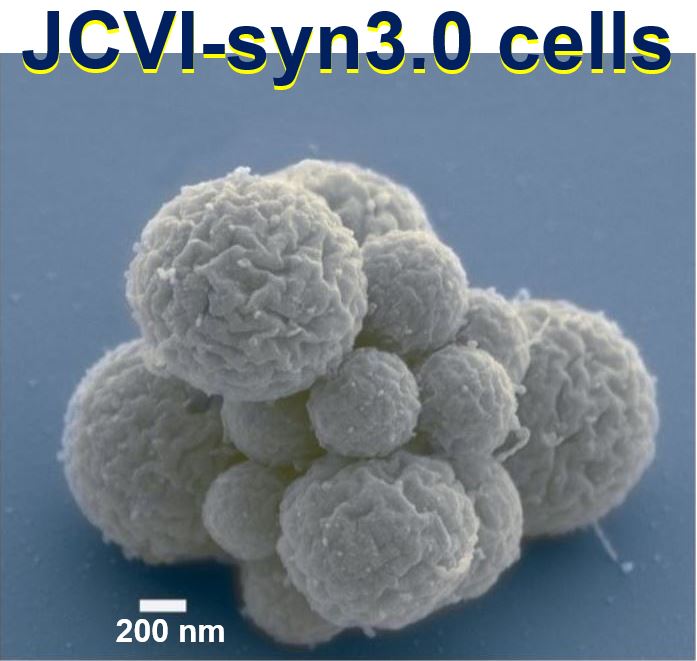A microbe with just 473 genes has been designed and synthesized by a team of scientists, who say this self-replicating organism could help us understand the secrets of life – how it all started and then developed on our planet all those billions of years ago.
Clyde A. Hutchison III, Professor Emeritus of Microbiology and Immunology at UNC-Chapel Hill, and Distinguished Professor at the J Craig Venter Institute, and colleagues wrote in the journal Science (citation below) that their breakthrough advances on research published in 2010 when the first self-replicating, synthetic bacterial cell was built and booted up.
The initial study proved that genomes could be designed in a computer, chemically made by humans in the lab, and transplanted into a recipient cell to produce new cells controlled only by the synthetic genome.
 Of the 473 genes in this minimal cell, 79 have no assigned functional category. The rest of them can be divided into four major groups. (Image: aaas.org)
Of the 473 genes in this minimal cell, 79 have no assigned functional category. The rest of them can be divided into four major groups. (Image: aaas.org)
Synthesizing the smallest-possible cell
Since then, the team set about its ultimate objective – to synthesize the smallest-possible cell containing just the genes required to sustain life at its simplest form.
The authors say their effort will help the scientific community understand the function of every essential gene within a cell.
To do this work, the scientists again turned to Mycoplasma, a genus of bacteria that lack a cell wall around their cell membrane – they possess the fewest genes of any autonomously replicating cells.
Six years ago, the team had synthesized the genome of Mycoplasma mycoides.
Here based on existing literature, the scientists designed hypothetical minimal genomes in a total of eight segments, with each one being tested in order to accurately determine which genes were essential and which weren’t.
 Design-build-test cycle for genome design by means of synthesis and cloning in yeast, and testing for viability by means of genome transplantation. Following each cycle, gene essentiality is reevaluated by global transposon mutagenesis. (Image: science.sciencemag.org)
Design-build-test cycle for genome design by means of synthesis and cloning in yeast, and testing for viability by means of genome transplantation. Following each cycle, gene essentiality is reevaluated by global transposon mutagenesis. (Image: science.sciencemag.org)
During this design-build-test process, the scientists also tried to identify the genes required for robust growth but not absolutely vital for life – the quasi-essential genes.
In a series of experiments, Prof. Hutchison, J. Craig Venter, Ph.D., Founder, Chairman, and Chief Executive Officer of the J. Craig Institute, and colleagues inserted transposons – foreign genetic sequences – into several genes to disrupt their functions and determine which ones were vital for the overall functioning of the bacteria.
They repeated experiments, whittling away at the synthetic, reduced genome, until no more genes could be disrupted and the genome was as small as possible.
Their analysis revealed that some genes that were initially classed as non-essential, did in fact perform the same essential function as a second gene, thus, one of the pair of genes needs to be retained in the minimal genome.
Creation of JCVI-syn3.0 with 473 genes
They eventually created a final version consisting of 473 genes – called JCVI-syn3.0. This genome is smaller than any current autonomously replicating cell we know of in nature.
Their minimal genome lacks all DNA-modifying and restriction genes and the majority of genes encoding lipoproteins.
 Comparison of JCVI-syn1.0 (blue circle) with JCVI-syn3.0 (red circle), showing the division of each into eight segments. The red bars inside the blue circle indicate regions that are retained in JCVI-syn3.0. (Image: science.sciencemag.org)
Comparison of JCVI-syn1.0 (blue circle) with JCVI-syn3.0 (red circle), showing the division of each into eight segments. The red bars inside the blue circle indicate regions that are retained in JCVI-syn3.0. (Image: science.sciencemag.org)
Contrastingly, nearly all the genes involved in reading and expressing the genetic information within the genome, as well as in preserving genetic data across generations, are retained.
Interestingly, they still do not know what the precise functions are of approximately 31% of the JCVI-syn3.0 genes.
However, many potential homologs for some of these genes were found in other organisms. This suggests that they encode universal proteins with functions we do not yet know about.
“The JCVI-syn3.0 platform represents a versatile tool for investigating the core functions of life,” the scientists said.
 A cluster of JCVI-syn3.0 cells, showing spherical structures of varying sizes. (Image: science.sciencemag.org)
A cluster of JCVI-syn3.0 cells, showing spherical structures of varying sizes. (Image: science.sciencemag.org)
Many essential genes with unknown function
Dr. Venter said regarding the number of essential genes:
“Our attempt to design and create a new species, while ultimately successful, revealed that 32% of the genes essential for life in this cell are of unknown function, and showed that many are highly conserved in numerous species.”
“All the bioinformatics studies over the past 20 years have underestimated the number of essential genes by focusing only on the known world. This is an important observation that we are carrying forward into the study of the human genome.”
Dr. Hutchison said regarding the Science paper:
“This paper represents more than five years of work by an amazingly talented group of people. Our goal is to have a cell for which the precise biological function of every gene is known.”
 (Left) Clyde A. Hutchison, (middle) J. Craig Venter and Daniel G. Gibson. For a full list of authors, see citation at the bottom of this page.
(Left) Clyde A. Hutchison, (middle) J. Craig Venter and Daniel G. Gibson. For a full list of authors, see citation at the bottom of this page.
Dr. Daniel G. Gibson, Vice President Synthetic Genomics Inc., and Associate Professor at the J. Craig Venter Institute, said:
“This paper signifies a major step toward our ability to design and build synthetic organisms from the bottom up with predictable outcomes. The tools and knowledge gained from this work will be essential to producing next generation production platforms for a wide range of disciplines.”
This work was funded by Synthetic Genomics, Inc., the J. Craig Venter Institute endowment, and the Defense Advanced Research Projects Agency’s Living Foundries program, HR0011-12-C-0063.
Citation: “Design and synthesis of a minimal bacterial genome,” Clyde A. Hutchison III, Ray-Yuan Chuang, Vladimir N. Noskov, Nacyra Assad-Garcia, Thomas J. Deerinck, Mark H. Ellisman, John Gill, Krishna Kannan, Bogumil J. Karas, Li Ma, James F. Pelletier, Zhi-Qing Qi, R. Alexander Richter, Elizabeth A. Strychalski, Lijie Sun, Yo Suzuki, Billyana Tsvetanova, Kim S. Wise, Hamilton O. Smith, John I. Glass, Chuck Merryman1, Daniel G. Gibson, and J. Craig Venter. Science. 25 March 2016. DOI: 10.1126/science.aad6253.
Video – JCVI-syn3.0: Minimal Cell
These are time lapse videos of the minimal cell (JCVI-syn3.0) and the wild type organism from which it was designed (JCVI-syn1.0). Magnified 1500X, the footage shows the growth of the bacteria over a period of 8 hours.
